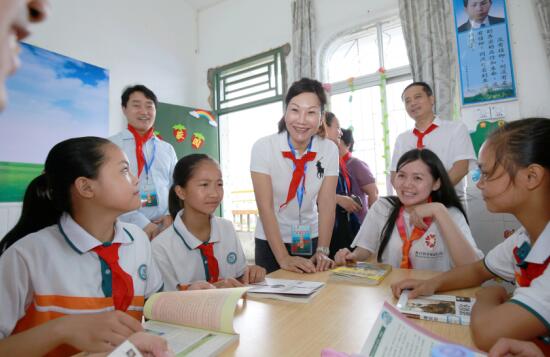
June 2004: the <Regulations for Foundations> is formally introduced.
June 2004: it is again possible to apply to start a foundation in Chongqing Municipality, after seven years in which applications are not processed.
July 2004: the Ye Kangsong Charitable Foundation of Wenzhou City is established by private entrepreneur Ye Kangsong, the first non-public fundraising foundation to be named after its sponsor.
2004: the Budweiser InBev Urban Development Foundation of Harbin City, the first listed fund in China, is established.
June 2005: the Heung Kong Charitable Foundation is established by the president of Heung Kong Company Zhai Meiqing. This is the first national non-public fund in China, with the batch number of “001” given by the Ministry of Civil Affairs.
January 2006: the Ministry of Civil Affairs releases the <Annual Inspection Methods for Foundations> and the <Foundation Information Disclosure Measures>.
December 2006: Liao Kaiyuan, the chairman of the Liao Kaiyuan charitable foundation, donated 123 million yuan to Pecking University. In the same year, the annual donations of the Educational Foundation of Tsinghua University reach 152 million yuan and the Educational Development Foundation of Beijing Jiaotong University reach 113 million yuan.
March 2007: the < Corporate Income Tax Law > is passed, stating that the part of the public welfare donations which is within 12% of total annual profit can be included in the calculation of taxable income deduction.
April 2008: the Ministry of Civil Affairs holds the “Foundation Assessment Work Summary and Awards Ceremony”, with 62 foundations participating in the evaluation.
April 2009: the Ministry of Civil Affairs issues the “Notice Prohibiting Foundations and Other Social Organisations from Providing Charitable Donation Rebates”.
July 2009: the <Agreement on the Comprehensive Reform of Civil Affairs> is signed by the Ministry of Civil Affairs and the Shenzhen Government, to explore how civil affairs departments below the provincial level can carry out the pilot work of managing the registration of foundations.
October 2009: the <Interim Measures for the Administration of Donations in Central-Level Ordinary Universities> is released by the Ministry of Finance and the Ministry of Education, in order to subsidise the implementation of the donations received by central-level ordinary universities.
December 2009: 24 foundations recommend that the State Council review the tax exemption policy documents.
July 2010: the Foundation Center Network, launched by 35 foundations, is established.
December 2010: the Ministry of Civil Affairs issues the <Administrative Measures for the Evaluation of Social Organizations>.
January 2011: the One Foundation is founded in Shenzhen, Guangdong Province, successfully making the transition from non-public fundraising to public fundraising foundation.
March 2011: Japan suffers a magnitude 9 earthquake and a huge tsunami, and 11 Chinese private foundations donate 1.42 million yuan to the affected areas, achieving the first joint donation overseas.
May 2011: China’s first foundation to take donated stock as its main asset, the Heren Philanthropic Foundation, is inaugurated.
May 2011: the first private foundation with a multinational-company background under the charge of the Ministry of Civil Affairs, the Amway Charity Foundation, is established.
March 2012: the thirteenth National Civil Affairs Conference decides to decentralise the right to approve non-public fundraising foundations and the authority to approve chambers of Commerce.
June 2012: the Ministry of Civil Affairs restarts the legislative process for the Charity Law, which has been suspended for years.
July 2012: the Ministry of Civil Affairs publishes <On Regulating the Behaviour of Foundations (for Trial Implementation)> on its official website.
August 2012: the Civil Affairs Department of Guangdong Province forwards a notice released by the Ministry of Civil Affairs, which consents to the non-public registration management authority being delegated to the Guangzhou Municipal Civil Affairs Bureau.
July 2012: the first national, comprehensive charity project exchange exhibition is held, the Shenzhen Charity exhibition.
October 2012: the Foundation Centre Network and Tsinghua University jointly issues the “China Foundation Transparency Index (FTI)”.
January 2013: with the permission of the Ministry of Civil Affairs, the Zhejiang Provincial Civil Affairs Department authorises the Wenzhou Municipal Civil Affairs Bureau to carry out the registration management of non-public fundraising foundations.
September 2013: the Beijing New Sunshine Charity Foundation is officially raised to the status of being a foundation.
January 2014: China’s first community foundation is launched, the Shenzhen Nankeng Community Charity Foundation. This is followed by the establishment of the first community charitable foundation in Pudong New Area, Shanghai. Then in March, the Taiyanggong Charity Foundation of Beijing is established.
September 2014: the Love Without Borders Foundation, the first non-public fundraising foundation launched by a non-governmental organisation aiming at AIDS prevention, is formally established.
December 2014: the SEE foundation becomes eligible for public offerings.
May 2015: the State Council issues the <Decision on the Abolition of Non-Administrative Licensing Matters>, including deducting qualification confirmation of the public welfare donations before tax.
July 2015: the first Chinese public fundraising conference is held.
September 2015: Tencent launches the “9.9 Public Day” activities.
March 2016: the Charity Law is passed in the fourth session of the twelfth National People’s Congress. The Charity Law is officially implemented on September 1st. September 5th becomes the annual “China Charity Day”.
May 2016: the Amway Charity Foundation’s annual report for 2015 reveals that the foundation’s original registered capital has been reduced from 100 million yuan to 50 million yuan. Reducing the original capital becomes an alternative for some non-public fundraising foundations when they face financial difficulties.
July 2016: the Ministry of Civil Affairs issues the <Guidance on Strengthening and Improving the Salary Management of Social Organisations>.
September 2016: the <Charitable Organisations’ Public Fund-Raising Management Approach> and the <Charitable Organisations’ Affirmation Approach> are implemented.
October 2016: the Ministry of Civil Affairs, the Ministry of Finance and the State Administration of Taxation delivers a notice on printing and distributing the <Provisions on Annual Charges and Charges for Charitable Activities>.



